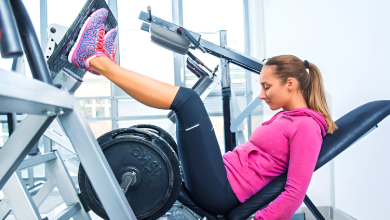The 10 Top Cable Back Exercises for a Stronger Back
Building your back should be one of your priorities if you want a well-rounded physique and a wider frame. Getting that V-shaped frame is the goal of every gym-goer.
But for building your back you need all sorts of equipment: barbells, dumbbells, resistance bands, tanks, planes, and automobiles… NOT TRUE! All you need is the cable machine.
If you only have the cable machine, you’ll be able to do every exercise for a wider back. You’ll only need to know which cable back exercises will work best for you. We’ll show you all of them and the instructions to do them.
Easy Navigation
1. Face Pulls
It’s good to start every workout with a good warmup exercise, but the value of face pulls extends way beyond just being a warmup exercise. It’s a corrective exercise that will help you fix your posture, fire up your rotator cuff, and get your shoulders and back ready for a tough workout.
We suggest doing face pulls as often as possible. But it’s also key to do them correctly because this exercise can quickly turn into an arm-building workout. It’s all about the rotation of your shoulder with this exercise, where you need to focus on bringing your hands backwards instead of your elbows.
It targets your posterior deltoids, mid and lower traps, as well as the infraspinatus and teres major (rotator cuff).
- With the rope attachment on the cable, grab the ropes in front of you and have your arms straight
- Pull the ropes towards your face and extend your elbows to the side when you come close to your face
- Let your hands beat your elbows when you extend your arms back instead of extending your elbows too much
2. Seated Cable Row
Rows are perhaps the best single movements to activate your lats, as well as your traps and deltoid muscles. It’s a hugely popular exercise as it mimics the way we use muscles in the real world.
This exercise will replace barbell rows. In some ways, it’s even more comfortable because you’re in a seated position and you won’t have to put so much strain on your back as you would with barbell rows.
- Sitting down on the floor or on a low bench in front of the cable machine, grab the cable handle with both of your hands
- Extend your arms forward and start pulling them backwards, as if you’re rowing
- Do it slowly and keep your back as straight as possible
3. Straight Arm Pushdown
The straight arm pushdown is one of the best exercises for targeting your lats. With this exercise, you’ll be able to use either the bar attachment or the rope attachment, although you will get some more mobility with the rope.
But one important thing to keep in mind here is to fully extend your arms as you do the movement. As soon as you bend your elbows, you’re turning this movement into a tricep pushdown.
- Bending slightly forwards with your upper body, grab the cable attachment with both of your hands in a shoulder-width position
- Keep your arms straight
- Start pulling the cable handle downwards slowly and bring it back up, but do it in a controlled manner
4. Lat Pulldowns (Wide and Close Grip)
With the lat pulldown, you have two variations: wide and close grip pulldowns. Overall, this is one of the most effective back exercises, right behind pull-ups and deadlifts. But if you have a compromised shoulder, you should take care with it.
We suggest doing this movement in front of you instead of behind your head, as some people suggest. This will minimize the risk of shoulder injuries.
Wide lat pulldowns are more common than close grip pulldowns; the main difference is in your hand positioning, although you will work mostly the same muscles – which is your upper back, especially your lats, traps, and rhomboids.
- Sitting down on the bench in front of the cable machine, grab the cable attachment with either the wide or close grip
- Keep your lower back straight and start pulling the bar towards your chest
Avoid behind the back pulldowns because it can injure your shoulder
5. Reverse Grip Lat Pulldown
There’s another variation of the lat pulldown, which is the reverse grip pulldown. Think of it like what chin-ups represent for pull-ups. It works your back muscles, especially your lats. But at the same time, you’ll be able to work your bicep muscles a bit more.
The technique is also slightly different here as it is with wide grip lat pulldowns. Here’s how to do them.
- With a reverse grip, grab the cable attachment with your hands extended fully (you might need to bend forwards slightly to grab the handle)
- Then, pull the handle towards yourself until you bring it as close to your body as possible
- Come back up slowly and fully extend your hands. Repeat
6. V-Bar Pulldowns
Another alternative to the standard, wide-grip pulldown is the V-bar pulldown. Essentially, this exercise is somewhat similar to the reverse grip lat pulldown. The main difference is that you’ll use the V-bar attachment to do the movement.
This will bring your hands a bit closer as you do the exercise. This makes it a bit more effective for your middle back, although you’ll also be able to feel your arms and shoulders work.
If you’re looking to add more width to your back, then v-bar pulldowns are just the ticket for you. But you’ll need to do them correctly, too.
- With the v-bar attachment on the cable machine, grab the attachment and extend your arms fully while sitting down
- Then, start pulling the v-bar towards your chest. Come as close to your chest as possible
- Make sure you do the movement in a controlled way, which means bringing the bar slowly down and upwards
- Don’t sway with your body too much, although a bit of sway is perfectly normal
7. Reverse Cable Flyes
Another great exercise for building your rhomboids and delts is the reverse cable fly. It’s especially effective for targeting your rear delts. This movement is excellent for improving your posture, especially if you suffer from a slouched back.
You’ll do this exercise standing. If you’ve never done this exercise, then it’s better to start light and then build your strength to do more repetitions and eventually, add more weight to the cable machine.
Mechanically, this exercise is a bit more complex than some other exercises on this list. You’ll want to keep your arms straight during the exercise, but also make sure you don’t rush it. Try to establish the mind to muscle connection.
- Grab the cable attachments while standing and bending slightly forwards, and have the attachment in the opposite hands as you do so
- Keeping your back straight, start moving the cable attachments backwards, but keep your arms straight, too
- Try not to move your upper body too much, although you can do so a bit to help yourself during the exercise
8. Shotgun Rows
This is an exercise with an interesting name, but it’s a great back movement that will target your lats primarily, but also your delts. In many ways, this exercise closely resembles the dumbbell single-arm rows, although this one is done standing and with the cable machine.
If you don’t have access to the seated cable machine, then you can replace the cable rows with shotgun rows. Because this exercise can be done standing, it’s a great exercise that you can do in almost any gym in the world.
At the same time, you’ll feel your abs and perhaps even your legs working to an extent. You’ll want to be as stable as possible as you do this exercise, which means strongly planting your feet onto the ground.
- Standing next to the cable machine, grab the handle and bend your knees slightly
- Start pulling the handle towards yourself, and move it back as your hand reaches your hips
- Try not to sway too much during the movement, and engage your core
9. Standing Cable Row
Another great alternative to the seated row is the standing cable row. The only downside is that you might not be able to lift as much weight as you would with seated cable rows, because you’ll have to keep your lower back and your legs engaged, too.
It’s a highly effective movement for strengthening your entire back, but especially your lats. You can consider this exercise as an alternative to the seated cable row, especially if you don’t have access to the seated rowing machine.
- Bend your knees slightly as you grab the cable attachment with both of your hands
- Start pulling the cable attachment towards yourself slowly
- Keep your legs and core engaged during the movement
10. One-Arm Seated Cable Row
Last but not least, we have the single-arm seated cable row. This movement can supplement seated cable rows, especially if you want to target each side of your back a bit more. It’s a great movement to isolate each side of your back at once.
At the same time, this exercise can be done as a finisher move, because you can do it even more explosively, which can add an important aspect to your training. The form here is crucial because you’ll need to keep your back straight, just as you would with normal seated cable rows.
- Seated on the cable rowing machine, grab the cable attachment with one of your hands
- Keep your back straight and start pulling your arm backward
- You can add a bit more weight here and do it more explosively if you want
- Repeat with your other hand
Example Back Cable Workout
So now that you know the best cable back exercises, it’s time to take a look at how a sample back cable workout would look like.
We’ve picked the best of the best here, so you can combine any of the exercises from the list. However, this workout we’ve provided here is meant to give you an all-rounded workout for your entire back.
You can also use alternative exercises if you don’t have access to the exercises that we’ve included in the sample workout.
- Face pulls – 3 sets of 8-12 reps
- Seated cable row – 3 sets of 8-12 reps – alternative: standing cable row
- Wide grip lat pulldown – 3 sets of 8-12 reps
- Close grip lat pulldown – 3 sets of 8-12 reps
- Reverse grip lat pulldown – 3 sets of 8-12
- Straight arm pushdown – 3 sets of 8-12
- Reverse cable flyes – 3 sets of 8-12
Workout notes: rest for a minute or two between each set and each exercise. The entire workout should take you around 45 minutes to an hour to complete. Do a proper warm-up before the workout, and don’t ignore the face pulls before the workout! If you don’t have access to the seated cable rowing machine, we’ve provided you with an alternative; you can also do shotgun cable rows or one-arm cable rows as alternatives.
Final Thoughts
The cable machine can be one of the best pieces of equipment for building your back. The best thing about is that you won’t need other pieces of gym equipment to build a wider back. With these cable back exercises, you’ll be able to target all of your back muscles and build a well-rounded, wide back with ease. Don’t forget about your diet, though!


